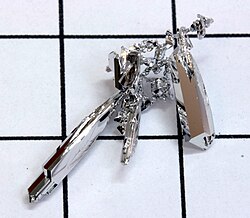Sunday, October 30, 2011
From Hydrogen to Tellurium - RUTHENIUM
Ruthenium
Calendar week 44 in this the International Year of Chemistry means element number 44 and that is Ruthenium with the chemical symbol Ru.. This transition metal has 44 electrons and therefore is in 44th position. This white metal is often grouped with rhodium, palladium, osmium, iridium, and platinum to make up the Platinum group metals.
Ruthenium doesn't react with air at normal temperatures and because of this it doesn't tarnish.
It was first discovered in Russia in the mid 1800s and was named after the latin name for Russia - Ruthenia. Ruthenium is sometimes found as a free metal, often along with other platinum group metals.
Ruthenium is very rare so people are unlikely to come across any ruthenium compounds in normal day to day activities however they these chemicals are considered toxic to humans.
Monday, October 24, 2011
From Hydrogen to Tellurium - TECHNETIUM
Technetium
The 43rd element is Technetium. It has the atomic symbol Tc. My knowledge of this element is very limited. In my research for this blog I discovered it it radioactive - a bye product of the radioactive decay of uranium. It has no biological role and is not found in nature. Apparently it was the first element to be synthesized. It was made by bombarding molybdenum with deuterium.
The 43rd element is Technetium. It has the atomic symbol Tc. My knowledge of this element is very limited. In my research for this blog I discovered it it radioactive - a bye product of the radioactive decay of uranium. It has no biological role and is not found in nature. Apparently it was the first element to be synthesized. It was made by bombarding molybdenum with deuterium.
Sunday, October 16, 2011
From Hydrogen to Tellurium - MOLYBDENUM
Molybdenum
At position 42 is another transition metal - Molybdenum. It sits in the middle of the transition metals with Chromium above it and Tungsten below it. Molybdenum is known by the chemical symbol Mo. It has 4 electrons in its outer orbital and forms compounds with many other elements including hydrogen, fluorine, chlorine, oxygen, nitrogen and sulphur.
Molybdenum doesn't exist as elemental metal in nature but it can be isolated from its oxide. The isolated metal is a silvery white colour.
Small traces of Molybdenum are necessary for life in all species.
Because it doesn't expand or soften when heated to very high temperatures Molybdenum is used in applications that have to withstand very high temperatures. It is added to steel to increase the strength.
Tuesday, October 11, 2011
From Hydrogen to Tellurium - Niobium
Niobium
Next in the series is Niobium - number 41. Scientists use the letters Nb for short. Another metal in the transition metals group, Niobium is a silvery, white, ductile metal with a bluish tinge.. Like many other metals, Niobium does not exist on its own in nature and although scientists found it in the early 1800s it wasn't until it was first extracted from minerals.
Chemically Niobium is very similar to Tantalum, the element that is beneath it in the periodic table. They are so similar that it is difficult to tell them apart.
Most of the Niobium we use today is produced in Brazil.
It is used mixed with other metals, particularly in steel to make it stronger. It is also used with other metals in super conducting magnets. Sometimes it is used in special commemorative coins.
It doesn't have a known biological role in humans, but as it isn't toxic it is sometimes used in jewellery and might be suitable for replacement body parts.
Next in the series is Niobium - number 41. Scientists use the letters Nb for short. Another metal in the transition metals group, Niobium is a silvery, white, ductile metal with a bluish tinge.. Like many other metals, Niobium does not exist on its own in nature and although scientists found it in the early 1800s it wasn't until it was first extracted from minerals.
Chemically Niobium is very similar to Tantalum, the element that is beneath it in the periodic table. They are so similar that it is difficult to tell them apart.
Most of the Niobium we use today is produced in Brazil.
It is used mixed with other metals, particularly in steel to make it stronger. It is also used with other metals in super conducting magnets. Sometimes it is used in special commemorative coins.
It doesn't have a known biological role in humans, but as it isn't toxic it is sometimes used in jewellery and might be suitable for replacement body parts.
Tuesday, October 4, 2011
From Hydrogen to Tellurium - ZIRCONIUM
Zirconium
Using the chemical symbol Zr, Zirconium is the 40th element. It is found in the second position of the second row of transition metals, below Titanium and above Hafnium. The reason scientists are interested in what lies above and below an element is because those elements that are above and below, although they have less or more electron shells, they all have the same number of electrons in their outer shells and it is this electron arrangement that contributes to the chemical behaviour. Hence elements in the same column have similar chemistry.It is not surprising therefore that Zirconium is a gray-white metal that looks like Titanium.
Interesting things about Zirconium are:
It is not found in its elemental state in nature - this means that you don't find lumps of Zirconium metal in the ground.
If you grind it up to make a powder and heat it up, it will burn spontaneously.
Though it has no known biological role, it is not thought to be poison.
It is found in some stars, lunar rock and some terrestrial rocks.
Some Zirconium containing minerals are used in jewellery.
Like titanium, Zirconium is sometimes used by doctors to replace worn out joints.
Subscribe to:
Posts (Atom)


